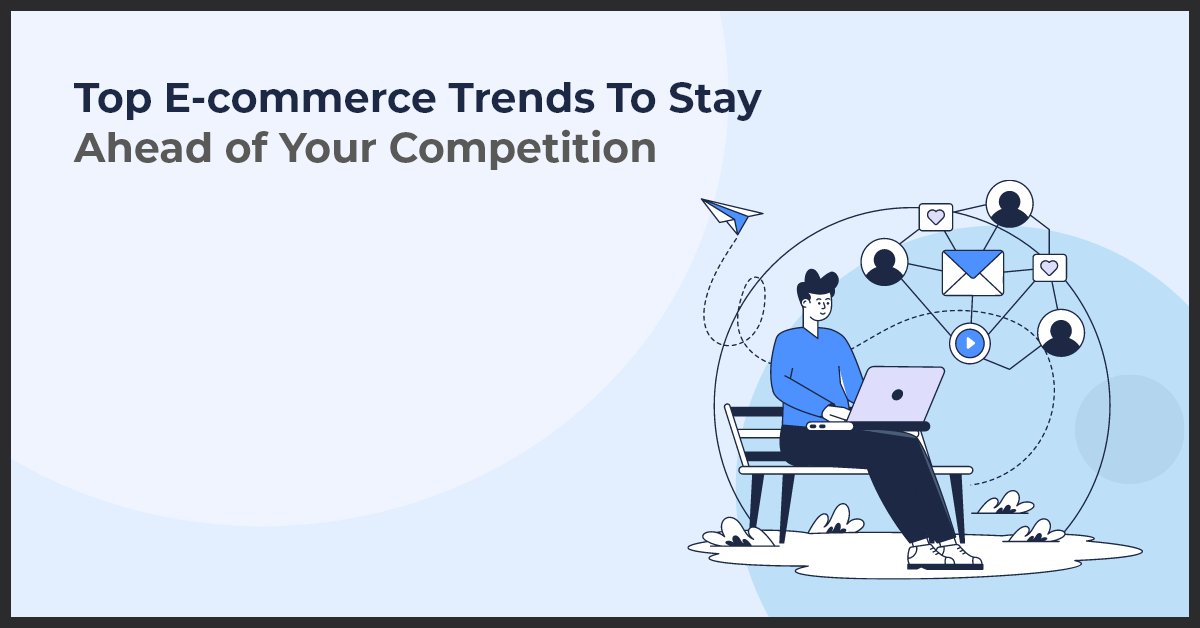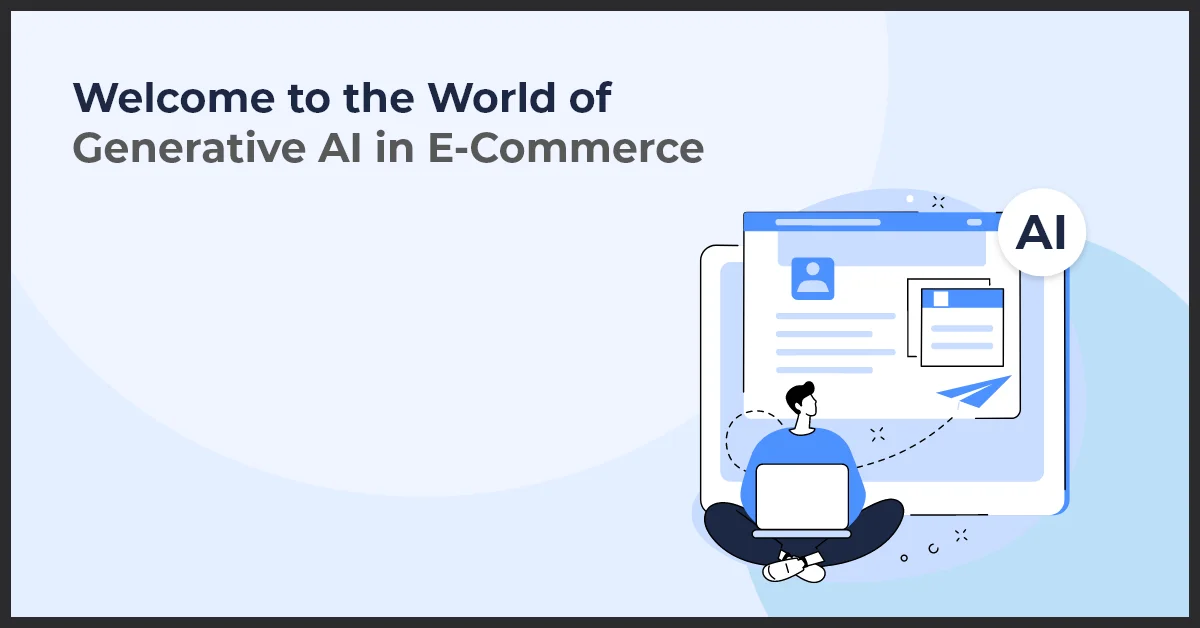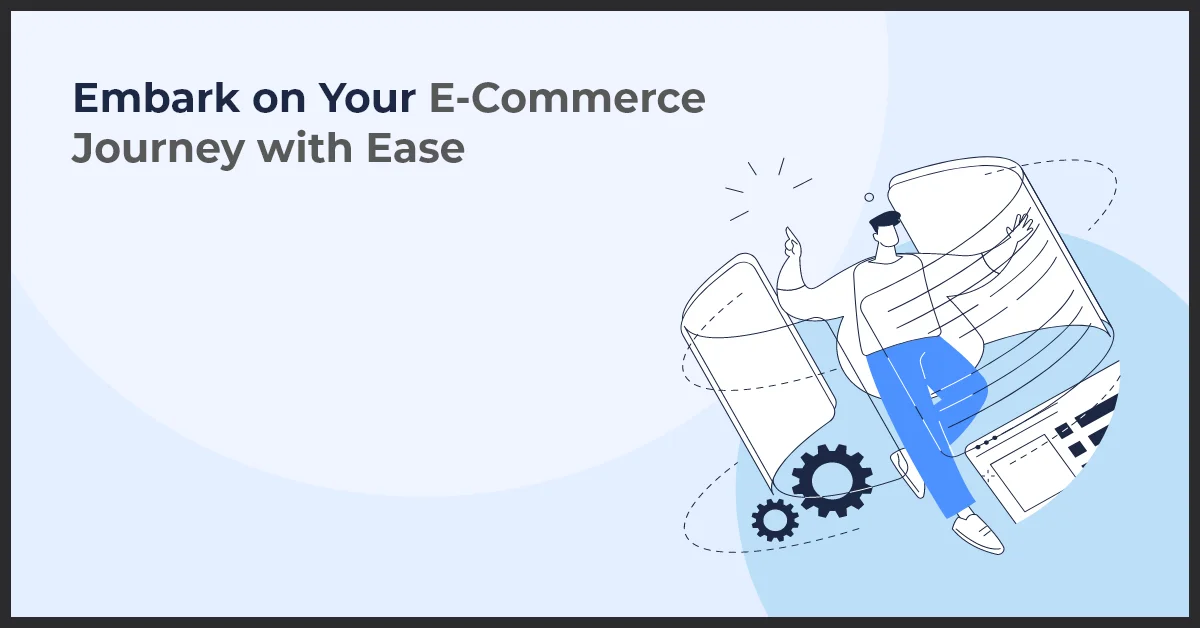Top E-commerce Trends To Stay Ahead of Your Competition

Published on: December 6, 2022
Updated on: September 04, 2024
1884 Views
- Ecommerce
22 min read
From its initial spur in the 1970s to when e-commerce website development started in the 1990s or to the expansion of new technologies in 2010 and its ongoing popularity till today, the e-commerce sector has evolved over a lifespan.
Though the initial growth started slowly, as we entered the 2000s, avant-garde technologies and innovations made e-commerce an omnipresent part of our lives today.
Earlier, the ecommerce sector mainly focused on the business to consumer (B2C) model, where convenience played a major role in increasing the demand among customers. Multiple players entered this sector, with retail being an early adopter, then followed by the service sector which started competition in this sector.
And with the COVID-19 pandemic, ecommerce saw terrific demand for supplies – from groceries to personal care and more, everything hyperdrives the demand of the ecommerce sector. If it was not for the pandemic, then it would have taken over five years to reach where it is today.
A Forbes report states e-commerce transactions reached $82.5 billion in May 2020 – which was a 77% increase from the previous year, 2019.
Not only this, the pandemic influenced the B2B ecommerce sector to look for digital options, switching from conventional in-person sales. Today, B2B e-commerce has become more transparent, effective, and prompt.
Fueled by phenomenal innovations, e-commerce has digitized the world into a single platform, and ever since its evolution, it continues to accelerate. So, to help you, we have beefed up the top 15 e-commerce trends that are expected to shape the industry in the future.
Top 15 E-commerce Trends to Look Out For
1. Voice-Enabled Shopping Will Be Common Practice
Google voice search has become one of the prominent features used in almost every smart device today. From Google Assistant to Siri to Alexa, people are using voice assistants throughout the day to play music, call people, check the weather, or even shop online.
A survey conducted by CouponFollow shows, almost 35.1% of customers use voice assistants daily, where Alexa is the most used voice assistant. The last few years have seen immense popularity of smart speakers, making them the heart of smart home setups.
Voice-enabled shopping has become an intuitive and automated way to shop that is loved by consumers today. Due to this popularity, more and more online retailers are providing voice-enabled shopping experiences to their consumers. This lets customers easily find the products without scrolling through multiple pages.
2. Personalization Will Be a Critical Element
More than a trend, personalization is the need for both B2B and B2C business models. Today, customers are bombarded with a plethora of marketing emails; so to stand out from the cut-through competition, companies need to offer some degree of personalization to keep consumers interested.
Whether you use it in your marketing emails or add it to your website, personalization is a surefire way to generate more sales. McKinsey's report shows that 76% of customers are more likely to purchase from brands that offer personalized content. And 78% of customers say they are more likely to repurchase because of personalization.
If you do not want to lose your customers to your competition, personalize your content all across the channels. Make them feel valued!
3. Chatbots Will Be the Biggest Need
Chatbots have become a major part of online business. Moreover, shoppers have started to interact more with chatbots. Today, consumers are looking for round-the-clock customer service, which is humanely difficult to provide.
So, to stand strong in the competitive market, e-commerce companies have to keep up with the change, making chatbots a smart investment. With artificial intelligence and machine learning, companies are developing chatbots to fill the service gap to answer customer queries 24*7.
What's more, chatbots also help in reducing operating costs for companies. From marketing to payment or processing to customer service, there are several different areas in which online retailers can leverage chatbots.
4. Omnichannel Marketing Will Be The Future
Creating a consistent consumer experience across numerous touchpoints is a key component of omnichannel retail. In-person interactions, website visits, mobile purchasing, and phone conversations are a few examples of these touchpoints.
Before making a purchase, a consumer can make contact with your brand through all of those channels. Therefore, their overall experience needs to be consistent while still being personalized for each specific outlet.
Ecommerce sales are frequently impacted by the ease that omnichannel experiences provide. In 2020, marketers who used three or more channels in any one campaign had a 287% increase in purchase rates compared to those who only used one channel.
5. Sustainability Will Play a Major Role
The demand for green ecommerce is increasing. Customers are spending more and more on sustainable products/brands. A survey from Statista shows, every one in two shoppers in the USA and UK wishes to buy products from brands with less packaging.
Moreover, 52% of customers say because of the pandemic, environmental sustainability has become crucial for them. So, if you want your online retail business to thrive, you need to be willing to acclimatize to more sustainable practices.
Even the slightest change can have an impact on how your target audience views your business, whether it be plastic-free packaging or paperless workplaces.
6. Customized Packaging Popularity Will Rise
As already mentioned, personalization and sustainability will play major roles in the future. This makes customized packaging a sound way for an e-commerce brand to address both personalization and environmental sustainability needs.
Today, online retail brands are going above and beyond by adding personal touches like special handwritten notes to thank the buyer or adding eco-friendly packaging to their website.
So when it comes to packaging, always keep in mind that it's not simply a box, it’s something your customers value a lot. Ensure that you add a personal touch so consumers will come back to shop more.
7. Data Protection Will Get More Importance
Personalization could be a powerful resource for customizing your customer experience, making it easier to persuade customers to make a purchase, and increasing their experience and engagement. However, collecting customer information is essential for creating personalized experiences. This brings up the topic of data privacy, which is a major concern for many customers.
Consumers today are resistant to sharing their personal details online. So, when it comes to personalization, it should not be at the expense of your customer’s all details. A survey shows, 86% of customers are more concerned about their privacy while 68% are concerned about the way businesses collect data.
So, it is best to be transparent about your data practices. Additionally, if you want to enhance client acquisition and retention, you should avoid keeping a customer's payment information or adding them to an email list as default choices.
8. Social Media Will Become a Major Player
Ignoring social media is equivalent to ending your e-commerce business. There are billions of users of social media globally, so if you do not capitalize on this niche, you are preparing for the worst.
Social media is a popular source of shopping inspiration for customers, especially with the online marketplace, and influencer marketing, social media has become a major sales driver for the ecommerce sector.
An online survey conducted in 2021 shows that 47% of social media users from the USA purchased from Instagram, and 51% of customers shopped from Facebook.
Utilize this trend for your online store by setting up social commerce shops on popular social networks for direct social selling. The best place to get going is on Facebook pages, Amazon Live, and Instagram Businesses.
9. Video Will Become Common Practice
You can draw in and hold the interest of your target audience by uploading videos to your website and social media accounts. More than 90% of individuals claim to find new products or brands via YouTube. Thus, ecommerce companies should start utilizing different types of video content to engage customers and highlight the advantages of their offerings.
You can take video creation to the next level by investing your time in making shoppable videos. With these videos, customers just need to click on one of the embedded clickable links and they will be taken to the page where they can learn more about a particular product or make an online purchase.
These interactive video ads are available in a range of formats, and they all provide customers with a streamlined experience from advertisement to purchase. Plus, more and more customers are using shoppable videos for purchases. So, investing in these is a smart decision.
10. Augmented Reality Will Be A Valuable Resource
Video and augmented reality have been important components of e-commerce for a while now. Customers can see products in 3D thanks to Augmented Reality. By incorporating augmented reality, online retailers that deal in jewelry, home furnishings, electronics, and fashion will be able to enhance customers’ shopping experiences.
By the end of this decade, the size of the augmented reality market is expected to surpass $50 billion. Consumers may visualize products via Augmented reality technology while sitting in their comfort zone.
Simply put, augmented reality is reducing one of the major obstacles to online shopping, and it's predicted that this trend will only grow over the coming year.
11. Leveraging Artificial Intelligence and Machine Learning
As we delve deeper into the age of digital transformation, Artificial Intelligence (AI) and Machine Learning (ML) are revolutionizing how online stores interact with customers. These advanced technologies are at the forefront, not just as buzzwords, but as key drivers in shaping the future of e-commerce.
AI's Role in Personalizing Online Shopping Experiences
AI is changing the game by offering highly personalized shopping experiences. Imagine walking into a store where the salesperson knows not only your name but also your fashion taste, preferred brands, and budget range. That's the level of personalization AI brings to the digital marketplace, making users feel uniquely understood and catered to through customized product recommendations and services.
Machine Learning Algorithms Enhancing Data Analytics and Prediction Accuracy
Behind the scenes, machine learning algorithms are meticulously analyzing consumer data, helping businesses make informed decisions. These algorithms evaluate past shopping patterns to forecast trends, manage inventory more efficiently, and optimize pricing strategies. By enhancing data analytics and prediction accuracy, e-commerce organizations can stay one step ahead in a highly competitive market.
The Influence of AI on Consumer Behavior and Sales Patterns
AI's impact extends beyond just analytics and personalization; it also shapes consumer behavior and sales patterns. AI tools provide valuable insights into consumer purchasing journeys, allowing brands to craft marketing strategies that align with real-time consumer needs and preferences. This results in better customer engagement, higher conversion rates, and ultimately, a boost in sales.
In conclusion, whether you're a startup or an established player, integrating AI and ML into your e-commerce strategy isn't a futuristic luxury—it's an essential component of staying relevant and competitive in today's ever-evolving digital landscape.
12. Customization through Personalization
In the constantly evolving landscape of e-commerce, personalization stands out as the golden standard for customer experience. Gone are the days of one-size-fits-all shopping; today's consumers crave a shopping experience that feels as unique as they are. Let's dive into the world of custom-tailored online shopping and uncover why personalization is rapidly becoming a cornerstone of e-commerce success.
Crafting Individual Customer Experiences
Everyone loves to feel special, and that's exactly what personalization achieves. By analyzing customer behavior, preferences, and past purchases, e-commerce platforms can curate products and services tailored to each shopper. The result? A seamless and immersive shopping journey that resonates with the individual, driving engagement and loyalty.
Data-Driven Personalization Strategies for Item Recommendations
With the power of data analytics, online retailers can now offer laser-focused item recommendations that hit the mark. These data-driven suggestions ensure that customers are presented with products they're more likely to purchase, not just because they might like them, but because the data says they will.
- Tracking browsing habits for insight into customer interests
- Utilizing purchase history to inform future product suggestions
- Analyzing click-through rates to refine recommendation algorithms
Personalization as a Differentiator in the Consumer Market
In a crowded marketplace, personalization is no longer just a nice-to-have; it's a critical differentiator. With multiple players offering similar products, the ability to provide a personalized shopping experience becomes a decisive factor in winning over customers. It's simple: when customers feel understood, they return, and they also become advocates for your brand.
13. The Emergence of Omnichannel Shopping
As we dive deeper into the world of e-commerce trends, we witness an incredible shift towards the integration of online and offline channels, paving the way for omnichannel shopping experiences. This isn't just about providing multiple shopping touchpoints—it's about creating a seamless, interconnected journey where each channel complements the others to serve the customer best.
Integration of Online and Offline Channels for Seamless Experiences
In the omnichannel approach, the aim is to dissolve the boundaries between digital and physical shops. This means you could start your shopping on an app, test a product in-store, and finally, make a purchase on the web, with the entire process feeling as natural as a conversation with an old friend.
The Importance of a Consistent Brand Presence Across All Channels
Maintaining a consistent brand presence across all platforms is not just essential—it's expected by today's savvy consumers. A customer might visit a Facebook page, then a website, and finally walk into a physical store. The key is to ensure a cohesive experience at every touchpoint, reinforcing recognition and trust in the brand.
14. Navigating the World of Voice Commerce
Welcome to the era where your voice is the key to effortless shopping! With the arrival of voice-activated shopping through smart assistants like Amazon's Alexa and Google Assistant, the e-commerce landscape is getting yet another revolutionary makeover.
The Rise of Voice-Activated Shopping via Smart Assistants
Imagine replenishing your pantry or updating your wardrobe with nothing but a few spoken words. Voice commerce makes this possible, allowing you to shop hands-free and multitask like a pro. As smart speakers and assistants gain popularity, more households are turning to voice commands for their purchasing needs.
Voice Commerce's Role in Changing How Customers Search and Buy Items
Not only is voice commerce empowering shoppers to make purchases from the comfort of their couch, but it's also changing the way we search for products. Typing out specific search terms is giving way to conversational queries, making the shopping experience more natural and intuitive.
Anticipating the Challenges and Opportunities of Voice Commerce
Yet, embracing voice commerce doesn't come without its hurdles. Companies must refine their SEO strategies to cater to voice searches, and the accuracy of voice recognition technology continues to evolve. But with challenges come opportunities: those who innovate in the voice commerce space are poised to reach early adopter customers and stand out in the market.
- Integrating voice shopping options to stay competitive
- Optimizing for voice search to capture new customer segments
- Understanding the importance of context and natural language in search queries
- Developing strategies to ensure privacy and security in voice transactions
The frontier of voice commerce is vast and brimming with potential. Are you ready to lend an ear and find your brand's voice in this emerging marketplace?
15. Strengthening Cybersecurity and Fraud Prevention
In today's ever-expanding digital landscape, the security of consumer information has never been more paramount. As we continue to witness the evolution of e-commerce trends, focusing on strengthening cybersecurity and fraud prevention is a must-do for online retailers.
The Necessity of Robust Security Measures to Protect Consumer Data
The reality is, cyber threats are growing in complexity and sophistication, and robust security measures are the cornerstone of consumer trust in the digital marketplace. Strong cybersecurity isn't just an option; it is an essential part of any e-commerce strategy. It helps to safeguard sensitive customer data, maintain privacy, and ensure a secure shopping experience.
Examples of Data Breaches and the Importance of Trust in Online Shopping
Recent high-profile data breaches have placed a spotlight on the consequences of inadequate security. These events not only result in direct financial loss but also significantly erode consumer confidence. Trust is the currency of e-commerce; once lost, it's incredibly challenging to regain.
The Latest Technologies and Best Practices in Fraud Prevention
To stay ahead of bad actors, e-commerce sites are rapidly adopting the latest technologies and best practices in fraud prevention. This includes employing multi-factor authentication, leveraging advanced encryption standards, and using real-time monitoring tools. Additionally, strong partnerships with cybersecurity firms and ongoing staff training in security best practices are invaluable investments in the integrity of e-commerce platforms.
- Multi-factor Authentication: Adds an extra layer of security by requiring additional verification beyond just a password.
- Advanced Encryption Standards: Ensures that data transferred between user and server cannot be read by unauthorized parties.
- Real-Time Monitoring Tools: Allows for the immediate detection and response to any suspicious activities on the platform.
In the conversation about e-commerce trends, cybersecurity is not just a buzzword—it's a fundamental part of the narrative for the future of secure online shopping and the continued growth of the digital marketplace.
Need for Speed: How Fast and Free Shipping is Becoming the Norm
As we navigate through the ever-evolving world of e-commerce, consumers have grown to anticipate that their online shopping experience will be accompanied by fast and free shipping. This expectation isn't just a passing trend—it's become a crucial aspect of online retail that can distinguish a successful business from its competitors. Let's unpack the pace at which this landscape is changing and how businesses are keeping up with these delivery demands.
Winning the Race with Free, Expedited Shipping
There's no denying the competitive advantage that comes with offering free and expedited shipping. In a digital marketplace where consumer loyalty is hard-earned, providing swift shipping at no extra cost can be the deciding factor that tips the scales in favor of your business. Adept retailers understand this and are continually optimizing their fulfillment strategies to deliver products at the speed of light—or at least as close to it as possible.
Decoding the Logistics of Lightning-Fast Shipping
The magic behind getting a package from A to B in record time involves a complex ballet of logistics. Retailers must not only partner with reliable shipping carriers but also leverage technological advancements to streamline their supply chain. The effects on the market are substantial, forging a path where fast shipping is not just a luxury, but a baseline expectation. For companies, the ability to deliver promptly means cultivating a strong logistical foundation that adapts to the rapid pace of e-commerce.
Finding Harmony Between Costs and Customer Happiness
At the intersection of shipping speed and cost-effectiveness, businesses are tasked with finding the sweet spot that maximizes customer satisfaction without eroding their bottom line. The balance is delicate; offering free shipping can be a significant investment on the part of the seller. Therefore, savvy businesses are always on the lookout for innovative ways to keep costs down, from negotiating carrier rates to optimizing package sizing. It's a juggling act of efficiency and customer delight, with successful retailers constantly tweaking the formula to deliver the best possible service at the most reasonable cost.
- Competitive advantage of offering free, expedited shipping options
- The logistics behind fast shipping and its effect on the market
- Balancing cost and customer satisfaction in shipping
The Role of Interactive Product Visualization
Imagine being able to see a product from every angle, customize its features, and truly visualize it in your own space before clicking that 'buy' button. Well, interactive product visualization is making this a reality in the world of e-commerce. This innovative approach is transforming how customers interact with products online, offering an immersive experience that ups the game from traditional static images.
Next-Generation Product Display Techniques
Gone are the days of simple product galleries. Today's e-commerce sites are employing sophisticated visualization tools that allow users to personalize and engage with products. These might include 360-degree views, zoom functionalities, and even virtual try-on solutions. Such interactive displays are not just cool tech; they're tools that bridge the gap between the digital and the physical, empowering customers to make informed decisions.
The Impact of High-Quality Visuals on Consumer Confidence and Sales
It's no secret that a picture is worth a thousand words. High-quality visuals significantly enhance consumer confidence, reducing the hesitation often associated with online shopping. Studies show that products with interactive views can boost conversion rates by up to 40%. When consumers feel more confident about what they’re buying, they’re likelier to follow through with the purchase.
The Technology Driving Enhanced Product Visualization
What's behind this visual revolution? A suite of cutting-edge technologies! Augmented Reality (AR) is at the forefront, allowing users to see how a product would look in their own environment. Web-based 3D modeling is another game-changer, presenting products in lifelike detail without the need for specialized apps or software. These tech advancements make shopping more engaging, informative, and fun – just what the modern consumer is searching for.
- 360-degree product views that offer a comprehensive view from every angle
- AR applications that project products into the user's actual space
- Web-based 3D models that are accessible across various devices and platforms
- High-resolution images that reveal texture and detail
- Real-time customization options allowing users to make products their own
As we continue to embrace the digital shift in shopping, interactive product visualization is rapidly becoming an e-commerce staple. It's not just about looking good — it's about providing a shopping experience that feels real, reliable, and altogether remarkable.
The Advancement of Chatbots and Customer Service Automation
In the swiftly evolving landscape of e-commerce, chatbots and customer service automation are not just trendy; they're revolutionizing the way businesses interact with customers. As we sail further into this digital age, understanding the intersection between technology and customer satisfaction has become paramount.
The Evolution of Automated Customer Service in E-Commerce
Gone are the days of waiting endlessly on the phone to have your queries answered. E-commerce has embraced automation, and now, chatbots are at the forefront, offering 24/7 assistance, resolving issues, and even closing sales. This constant availability not only enhances customer experience but also streamlines business operations significantly.
Benefits of Chatbots for Both Customer Satisfaction and Operational Efficiency
It's a win-win situation; chatbots provide immediate responses, which keep customers happy and reduce the bounce rate. They're not just programmed for generic replies but can also handle complex queries, order tracking, and provide personalized recommendations. On the flip side, they offer businesses scalability, handling thousands of interactions simultaneously without compromising quality, thereby boosting operational efficiency.
Best Practices for Deploying Customer Service Automation Without Losing Personal Touch
While automation is the way forward, maintaining a human touch is essential. Here are some best practices:
- Ensure chatbots are equipped with a friendly and conversational tone to make interactions feel more personal.
- Program your chatbot to recognize when a customer's needs surpass its capabilities and have a smooth handoff process to a human representative.
- Use customer data to personalize conversations, showing customers that you understand their needs and history with your brand.
- Regularly update and train your chatbots with the latest information and customer interaction data to keep improving the service.
By merging the efficiency of automation with the irreplaceable value of human connection, e-commerce businesses are setting new benchmarks in customer service quality. Ultimately, the goal is to ensure that even as bots become more advanced, the customer feels heard, helped, and valued, solidifying their loyalty to the brand.
Unlocking E-commerce Success: Harnessing Big Data and Analytics
As the e-commerce industry skyrockets, the savvy retailers who stay ahead of the curve understand that big data and analytics are not just buzzwords—they are the keys to unlocking consumer behavior patterns and driving strategic decision-making. Let's dive into how big data is revolutionizing the way we approach online shopping and what challenges lie ahead in transforming numbers into actionable business strategies.
The Strategic Advantage of Big Data in Understanding Consumer Patterns
Imagine having a crystal ball that reveals what your customers will buy, when they will buy it, and what motivates their purchasing decisions. Big data is that crystal ball. By tapping into oceans of consumer data—from browsing histories to purchase records—businesses can tailor their offerings with precision, ensuring that they meet customer demands and stay two steps ahead of the competition.
Case Studies Illustrating the Effective Use of Analytics in E-commerce
- Consider the success story of a major online retailer who leveraged analytics to optimize their inventory, eliminating stockouts during peak seasons.
- Or the fashion outlet that used customer data to offer personalized recommendations, skyrocketing their conversion rates.
The Challenge of Turning Large Data Sets into Actionable Insights
While the potential of big data is clear, the hurdle remains: how do we translate vast amounts of data into insights that can drive growth? Innovative analytics tools and a skilled workforce are essential in deciphering this complex data language. Nonetheless, with the right approach, e-commerce businesses can transform data into a strategic roadmap that navigates the ever-changing consumer landscape.
In conclusion, as we continue to witness the transformative impact of big data and analytics in e-commerce, one thing is certain—the future belongs to those who can not only collect but also intelligently analyze and act upon data. Stay tuned for more emerging trends that are shaping the online shopping world!
Conclusion
The e-commerce sector is enormous, especially with cut-throat competition and innovative developments and trends. So, stay ahead of your competitors by being prepared for the future.
Remember to focus on providing a customer-centric experience when you follow these trends to develop your e-commerce strategy. Whenever in doubt, put yourself in the shoes of your customers – think about what they will like - and your half job is already done.
Even though it might be challenging to stay ahead of the curve with ecommerce trends, doing so will help your company stand out in a saturated market.
If you are looking to learn more about these trends, reach out to our experts at info@growthnatives.com.



